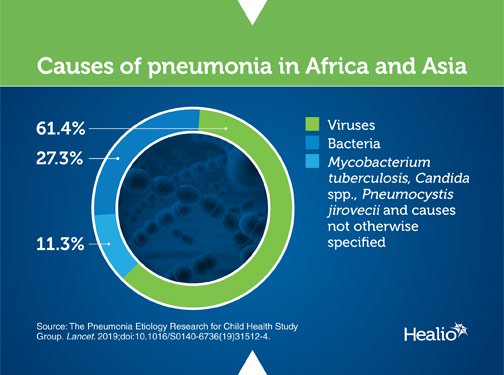RSV leading cause of pediatric pneumonia cases in Africa, Asia
Click Here to Manage Email Alerts


Researchers have found that leading causes of pneumonia requiring hospitalization in children aged younger than 5 years in low- and middle-income countries throughout Africa and Asia are viral, not bacterial. Specifically, respiratory syncytial virus, or RSV, caused the most cases.
They suggested that the routine use of pneumococcal conjugate and Haemophilus influenzae type b vaccines have protected children against major causes of bacterial pneumonia.
“The viruses that caused pneumonia in the African and Asian sites are also commonly found in the United States and other high-income countries,” Maria Deloria Knoll, PhD, a senior scientist in the department of international health at the Johns Hopkins Bloomberg School of Public Health, told Infectious Diseases in Children.
However, the risk factors for viral pneumonia are more prevalent in low- and middle-income countries, Knoll added, “including living in overcrowded households, poor nutrition, poor indoor air quality due to burning coal and wood, and higher risk for other comorbidities — all of which increase susceptibility to infection.”
Knoll and colleagues from the Pneumonia Etiology Research for Child Health (PERCH) Study Group conducted a case-control study in nine sites Bangladesh, The Gambia, Kenya, Mali, South Africa, Thailand and Zambia. The study, which lasted 2 years, included more than 1,700 children aged 1 to 59 months who were hospitalized with severe pneumonia, which they noted is the leading cause of death globally among children aged younger than 5 years. The researchers assessed the prevalence of the organisms causing the children’s pneumonia using cultures, multiplex PCR, or both. A group of about 5,100 aged-matched controls were randomly selected from communities around the study sites.

Knoll and colleagues estimated that 61.4% (95% CI, 57.3%-65.6%) of pneumonia cases were caused by viruses, whereas 27.3% (95% CI, 23.3%-31.6%) were caused by bacteria and 5.9% (95% CI, 3.9-8.3) were caused by Mycobacterium tuberculosis. Very severe cases of pneumonia were more likely to be caused by bacteria (very severe cases = 33.7% [95% CI, 27.2%-40.8%]; severe cases = 22.8% [95% CI, 18.3%-27.6%]) compared with viral infections (very severe cases = 54.5% [95% CI, 47.4%-61.5%]; severe cases = 68% [95% CI, 62.7%-72.7%]).
RSV was identified as the cause of 31.1% (95% CI, 28.4%-34.2%) of all cases, making it the most common cause of pneumonia. Several pathogens — human rhinovirus, human metapneumovirus A or B, human parainfluenza virus, Streptococcus pneumoniae, M. tuberculosis and H. influenzae — each contributed to 5% or more of cases.
In a related commentary, Trevor Duke, MD, from the University of Melbourne, stressed that in the era of the pneumococcal conjugate vaccine, it is important to understand the diverse causes of acute lower respiratory infections in children.
“The finding that the majority of cases were viral in etiology suggests that strategies need to be implemented to restrict antibiotic prescription in acute lower respiratory infections and, particularly, to identify children with the clinical syndrome of acute bronchiolitis, for whom antibiotics can be withheld,” he wrote. “This implementation is not easy in low- and middle-income countries where bacterial and viral acute lower respiratory infections often coexist, and when wheezing is not specific for viral infection.”
Study researcher Laura L. Hammitt, MD, an associate professor in the department of international health at the Bloomberg School of Public Health, told Infectious Diseases in Children that RSV — a disease for which there is currently no licensed vaccine — can still be a target for reducing pneumonia in children.
“Mothers can make sure to breastfeed their children to confer protective antibodies to them,” she said. “Prenatal care can help to ensure a normal pregnancy and prevent premature births that greatly increase the risk for RSV. Proper nutrition, including nutrients such as zinc and vitamin A, are important for strong immune function needed to fight disease, as well as providing children with good air quality by using clean-burning cooking and heating fuels and eliminating outdoor air pollution in the environment.”– by Katherine Bortz
Disclosures: Knoll reports receiving funding for consulting with Merck, Novartis and Pfizer, and grant funding from Merck. Hammitt reports receiving funding from GlaxoSmithKline and Pfizer. Please see the study for all other authors’ relevant financial disclosures.
